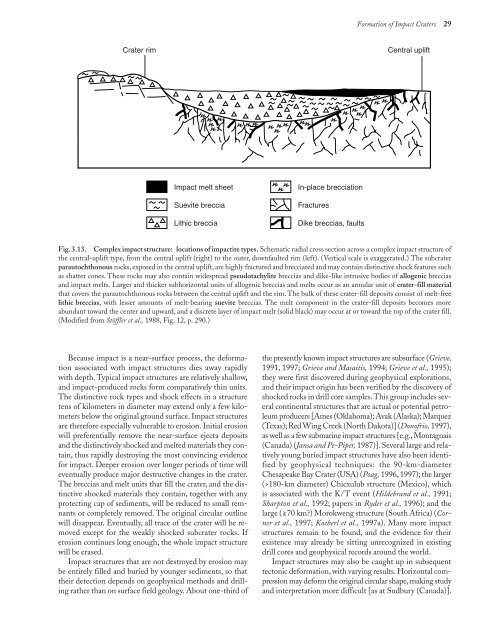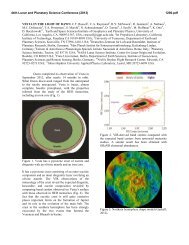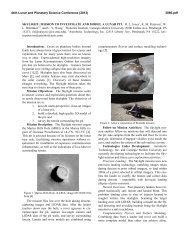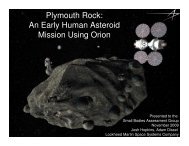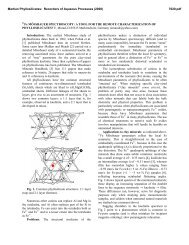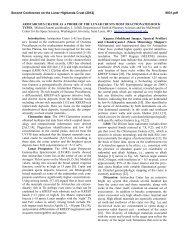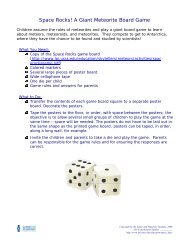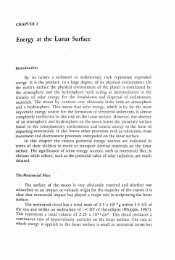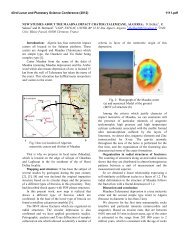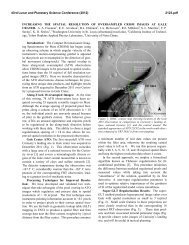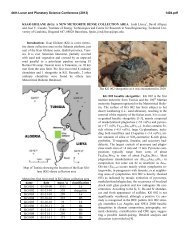Formation of Impact Craters - Lunar and Planetary Institute
Formation of Impact Craters - Lunar and Planetary Institute
Formation of Impact Craters - Lunar and Planetary Institute
You also want an ePaper? Increase the reach of your titles
YUMPU automatically turns print PDFs into web optimized ePapers that Google loves.
<strong>Formation</strong> <strong>of</strong> <strong>Impact</strong> <strong>Craters</strong> 29<br />
Fig. 3.13. Complex impact structure: locations <strong>of</strong> impactite types. Schematic radial cross section across a complex impact structure <strong>of</strong><br />
the central-uplift type, from the central uplift (right) to the outer, downfaulted rim (left). (Vertical scale is exaggerated.) The subcrater<br />
parautochthonous rocks, exposed in the central uplift, are highly fractured <strong>and</strong> brecciated <strong>and</strong> may contain distinctive shock features such<br />
as shatter cones. These rocks may also contain widespread pseudotachylite breccias <strong>and</strong> dike-like intrusive bodies <strong>of</strong> allogenic breccias<br />
<strong>and</strong> impact melts. Larger <strong>and</strong> thicker subhorizontal units <strong>of</strong> allogenic breccias <strong>and</strong> melts occur as an annular unit <strong>of</strong> crater-fill material<br />
that covers the parautochthonous rocks between the central uplift <strong>and</strong> the rim. The bulk <strong>of</strong> these crater-fill deposits consist <strong>of</strong> melt-free<br />
lithic breccias, with lesser amounts <strong>of</strong> melt-bearing suevite breccias. The melt component in the crater-fill deposits becomes more<br />
abundant toward the center <strong>and</strong> upward, <strong>and</strong> a discrete layer <strong>of</strong> impact melt (solid black) may occur at or toward the top <strong>of</strong> the crater fill.<br />
(Modified from Stöffler et al., 1988, Fig. 12, p. 290.)<br />
Because impact is a near-surface process, the deformation<br />
associated with impact structures dies away rapidly<br />
with depth. Typical impact structures are relatively shallow,<br />
<strong>and</strong> impact-produced rocks form comparatively thin units.<br />
The distinctive rock types <strong>and</strong> shock effects in a structure<br />
tens <strong>of</strong> kilometers in diameter may extend only a few kilometers<br />
below the original ground surface. <strong>Impact</strong> structures<br />
are therefore especially vulnerable to erosion. Initial erosion<br />
will preferentially remove the near-surface ejecta deposits<br />
<strong>and</strong> the distinctively shocked <strong>and</strong> melted materials they contain,<br />
thus rapidly destroying the most convincing evidence<br />
for impact. Deeper erosion over longer periods <strong>of</strong> time will<br />
eventually produce major destructive changes in the crater.<br />
The breccias <strong>and</strong> melt units that fill the crater, <strong>and</strong> the distinctive<br />
shocked materials they contain, together with any<br />
protecting cap <strong>of</strong> sediments, will be reduced to small remnants<br />
or completely removed. The original circular outline<br />
will disappear. Eventually, all trace <strong>of</strong> the crater will be removed<br />
except for the weakly shocked subcrater rocks. If<br />
erosion continues long enough, the whole impact structure<br />
will be erased.<br />
<strong>Impact</strong> structures that are not destroyed by erosion may<br />
be entirely filled <strong>and</strong> buried by younger sediments, so that<br />
their detection depends on geophysical methods <strong>and</strong> drilling<br />
rather than on surface field geology. About one-third <strong>of</strong><br />
the presently known impact structures are subsurface (Grieve,<br />
1991, 1997; Grieve <strong>and</strong> Masaitis, 1994; Grieve et al., 1995);<br />
they were first discovered during geophysical explorations,<br />
<strong>and</strong> their impact origin has been verified by the discovery <strong>of</strong><br />
shocked rocks in drill core samples. This group includes several<br />
continental structures that are actual or potential petroleum<br />
producers [Ames (Oklahoma); Avak (Alaska); Marquez<br />
(Texas); Red Wing Creek (North Dakota)] (Don<strong>of</strong>rio, 1997),<br />
as well as a few submarine impact structures [e.g., Montagnais<br />
(Canada) (Jansa <strong>and</strong> Pe-Piper, 1987)]. Several large <strong>and</strong> relatively<br />
young buried impact structures have also been identified<br />
by geophysical techniques: the 90-km-diameter<br />
Chesapeake Bay Crater (USA) (Poag, 1996, 1997); the larger<br />
(>180-km diameter) Chicxulub structure (Mexico), which<br />
is associated with the K/T event (Hildebr<strong>and</strong> et al., 1991;<br />
Sharpton et al., 1992; papers in Ryder et al., 1996); <strong>and</strong> the<br />
large (>70 km?) Morokweng structure (South Africa) (Corner<br />
et al., 1997; Koeberl et al., 1997a). Many more impact<br />
structures remain to be found, <strong>and</strong> the evidence for their<br />
existence may already be sitting unrecognized in existing<br />
drill cores <strong>and</strong> geophysical records around the world.<br />
<strong>Impact</strong> structures may also be caught up in subsequent<br />
tectonic deformation, with varying results. Horizontal compression<br />
may deform the original circular shape, making study<br />
<strong>and</strong> interpretation more difficult [as at Sudbury (Canada)].


